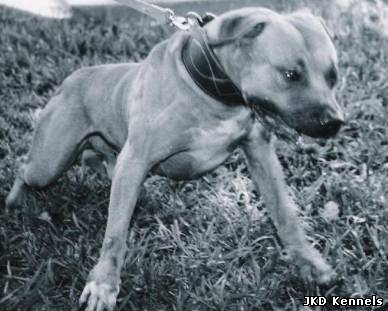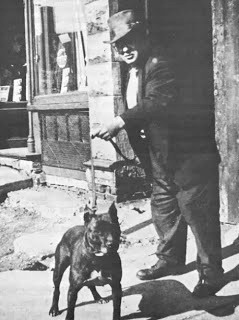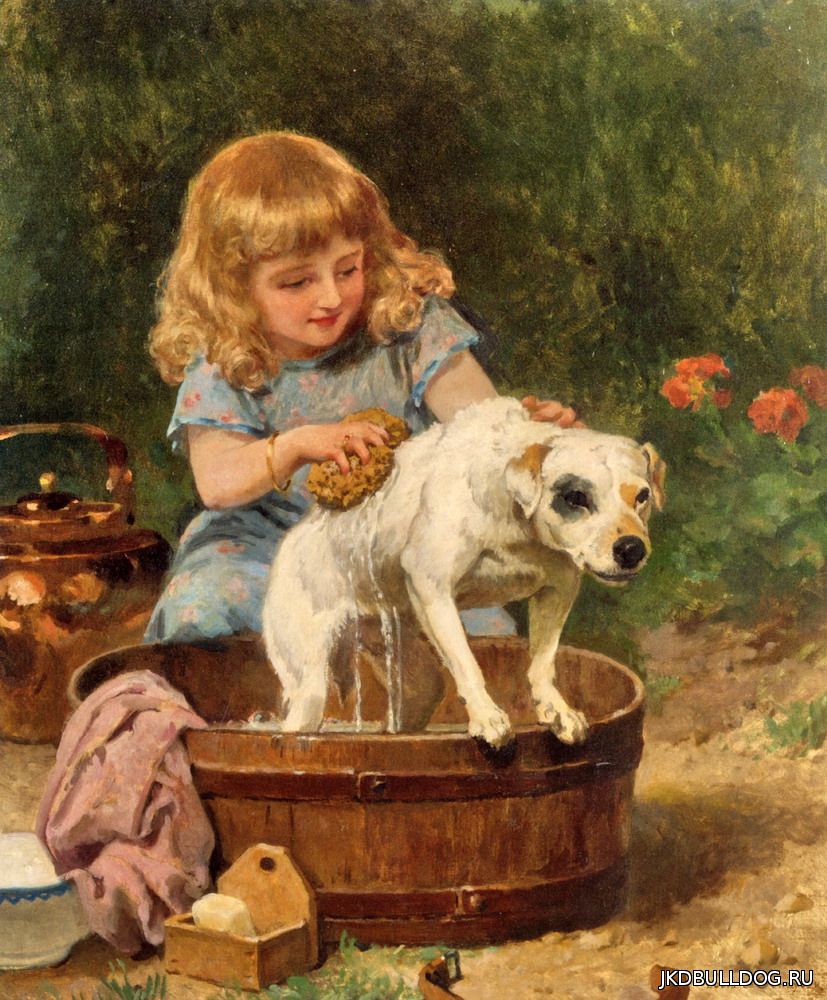KEN ALLEN & THE A TEAM'S KEEP
A GOOD KEEP
FOREWORD
Training or condition a Pit Bull dog for show or for combat is an individual effort. Your success will depend upon the amount of time and effort you are willing to spend on your dog. This keep is based upon the idea that anyone can bring a dog up to, say, 50% of his potential for strength and endurance. A top amateur can train a dog to 75%, while a top professional can consistently show dogs at around 90% - or more of their potential. This method will take you step-by-step through a complete training cycle for a combat dog.
CONDITIONING
It is my theory that if dog A and dog B are equal in natural ability and gameness and dog A has been better prepared (conditioned) for his fight than dog B, then dog A should win the match; and he will 9 times out of 10. In this keep we will try to do everything possible to help our dog's chances of winning while not doing anything to hurt him in any way. I believe that, in training, if you do 10% or 15% more for your dog than your opponent does for his, then you will win-at least 4 times out of 5. 1 might add that it is the little things that count in the long run. You must follow the general formula of this keep, if you wish to see the maximum benefit and the best results.
SCHOOLING
Your dog has to learn to fight and even though he has a lot of natural desire he needs practice to make perfect. Start rolling him 10 minutes at a time at 15 or 16 months and then every 6 weeks thereafter. Every other time add 5 more minutes to the roll so that at 2 years he goes 25 minutes. By this time your dog will have enough experience to know for sure what's going on.
TESTING
There is only one good way to test your dog. At 26 or 27 months roll him into a dog bigger than him for 30 minutes then put a fresh dog on him for about 10 minutes and scratch them 4 or 5 times. If your dog acts good and scratches good through this then he is ready for a match.
FEEDING AND WEIGHT
It is best for the dog and easier on your pocket book to keep your dog within 3 or 4 pounds of his fighting weight all the time. Excess weight and fat just strain the heart and vascular system. If your dog is more than 3 pounds over match weight, then prior to the keep you should put him on a low fat, high protein diet. Weigh your dog each day just prior to feeding. Never try to take off more than one pound per week. Any more will weaken him. Your feed should consist of 1/4 to 1/2 pound of lean meat and cottage cheese and 1-1/2 to 2 1/2 cups of Purina protein dog feed once per day, depending on the size of the dog. Neck meat off of a bull is the best meat you can get. Always feed the meat in big pieces so it will take longer to pass through the dog. Quite often you can find an animal by-products factory in your area. These places pick up fresh, dead or crippled livestock from farmers, and you can buy fresh beef or horsemeat at around . 10 or.12 cents a pound. Never feed your dog more than he will eagerly eat. If for some reason he doesn't eat eagerly, take the feed away until his next scheduled feed -- this will bring his appetite around. Always weigh or measure the feed. No guesswork. If you weigh the meat and measure the dry feed, then as you weigh your dog each day, you can increase or decrease his feed to control his weight. Do not try to fight your dog too thin as it will weaken him. Always watch the dog's stool every day for any unusual signs such as blood or diarrhea. His stool will give you a daily indicator of his general health. Always keep fresh water available to the dog. Bottled mineral water is also very good for him. Allow your dog to cool out after working him before giving him any water.
Feeding at night is the best, as a general rule. Most matches are at night and it is important for your dog to be empty at the time of the match. No feed the last 24 hours before a match. No water the last 12 hours. Try to be as regular as possible about the time of feeding. In hot weather your dog will eat better at night when it is cool.
Give your dog a One-A-Day vitamin + Iron and one table spoon of Clovite conditioner in his feed each day.
Wash his feed bowl before you feed each day and give him fresh water every day.
WORK
Before you start the keep you should give your dog several days or even 2 or 3 weeks of 10 or 15 minutes workouts. Either roadwork or on a treadmill is fine. This will get him used to working and will toughen his feet. Always pay careful attention to his feet for cuts, bruises, or for wearing his pads thin. I like to paint his pads with Bonocain until they get tough. Bonocain is also good for any injuries to his pads.
Always avoid over-working your dog. If he gets overly tired or starts breathing rough and straining during a work out, stop and walk him until his breathing becomes normal and easy. As you gradually increase his work, your dog will get a little more exhausted, but he should take the amount of work in this keep with no difficulty. If the situation arises that he can't take the daily increases, give him the amount of work he can take for a few days. He will soon be ready to get back on schedule. Remember too, dogs have their bad days just like humans. If he doesn't act really eager during a workout, rest him that day. That will sharpen him back up.
Hand walking is one of the best ways to get your dog in top condition. It is a little harder on the trainer, but it really pays off in the pit. You cannot overwork your dog by walking him. if you have the time, up to 5 miles per day is ideal. Always walk your dog 1/2 mile before and after each workout. This is the least amount of walking you can get by with and still get top condition.
The amount of work called for in this keep will bring your dog to a peak of condition. But if your dog runs especially hard, you may have to give him a little less work. If you have a lazy dog, it will just take a lot of patience on your part. If you have a lazy dog, you can let him run after a cat one day and a chicken the next. Or you can experiment around and possibly find some other animal he likes especially well.
This work schedule is the most desirable but you should be flexible enough to fit it to each individual dog according to his ability. Remember, some dogs just have a lot more natural wind than others. This schedule is listed both in miles and in minutes on a treadmill. If you use a mill, it is very important that it runs free and doesn't make your do pull too hard.
FIRST WEEK:
Sunday - No work.
In the afternoon give him a 2 cc injection of Combiotic and 2 tablespoons of Milk of Magnesia
Monday - 3 miles or 15 minutes
1/2 teaspoon B-15
Tuesday - 3 1/2 miles or 18 minutes
1/2 Tsp. B-15, 1 /2 cc male hormone 1/2 cc B-12
Wednesday - 4 miles or 21 minutes
1/2 Tsp. B- 15
Thursday - 4 1/2 miles or 24 minutes
1/2 Tsp. B-15
Friday 5 miles or 27 minutes
1/2 Tsp. B-15, 1/2 cc male hormone 1/2 cc B-12
Saturday 5 1/2 miles or 30 minutes
1/2 Tsp. B- 15
SECOND WEEK
Sunday - Rest - 1/2 Tsp. B- 15
Monday - 6 miles or 33 minutes
1/2 Tsp. B- 15
Tuesday - 6 1/2 miles or 36 minutes
1/2 Tsp. B-15,1/2 cc male hormone 1/2 cc B-12
Wednesday - 7 miles or 39 minutes
1/2 Tsp. B-15
Thursday - 7 1/2 miles or 42 minutes
1/2 Tsp. B-15
Friday - 8 miles or 45 minutes
1/2 Tsp. B-15,1/2 cc male hormone 1/2 cc B-12
Saturday - 8 1/2 miles or 48 minutes
1/2 Tsp. B-15
THIRD WEEK
Sunday - Rest - 1/2 Tsp. B-15
Monday - 9 miles or 51 minutes
1/2 Tsp. B-15
Tuesday - 9 1/2 miles or 54 minutes
1/2 Tsp. B-1 5, 1/2 cc male hormone 1/2 cc B-12
Wednesday - 10 miles or 57 minutes
1/2 Tsp. B- 15
Thursday 10 1/2 miles or 1 hour
1/2 Tsp. B-15
Friday 11 miles or 1 hr. 3 min.
1/2 Tsp. B-15,1/2 cc male hormone
Saturday 11 1/2 miles or 1 hr. 6 min.
1/2 Tsp. B-15
FOURTH WEEK
Sunday - Rest - 1/2 Tsp. B-15, 2 cc Combiotic
Monday - 12 miles or 1 hr. 9 min.
1/2 Tsp. B-15
Tuesday - 12 1/2 miles or I hr. 12 min.
1/2 Tsp. B-1 5. 1/2 cc male hormone, one 1/2 cc B-12
Wednesday - 13 miles or I hr. 15 min.
1/2 Tsp. B- 15
Thursday - 13 1/2 miles or 1 hr. 18 min.
1/2 Tsp. B-15
Friday - 14 miles or 1 hr. 21 min.
1/2 Tsp. B-15,1/2 cc male hormone 1/2 cc B-12
Saturday - 14 1/2 miles or I hr. 24 min.
1/2 Tsp. B-15
FIFTH WEEK
Sunday - Rest - 1/2 Tsp. B- 15
Monday - 15 miles or 1 hr. 27 min.
1/2 Tsp. B-15
Tuesday - 15 miles or 1 hr. 30 min.
1/2 Tsp. B-15,1/2 cc male hormone
1/2 cc B-12 (This will be the last injection of B-12)
Wednesday - 15 miles or 1 hr. 30 min.
1/2 Tsp. B-15
Thursday - 15 miles or 1 hr. 30 min.
1/2 Tsp. B-1 5
Friday - 15 miles or 1 hr. 30 min.
1 Tsp. B- 15, 1/2 cc male hormone
Saturday - 15 miles or 1 hr. 30 min.
1 Tsp. B-15
SIXTH WEEK
Sunday - Rest - 1 Tsp. B-15
Monday 10 miles or 1 hr.
Tuesday 10 miles or I hr.
Wednesday 5 miles or 30 minutes
Thursday Hand walk 3 miles
1 Tsp. B-15
Friday Hand walk 2 miles
1 Tsp. B-15, Approximately 24 hours before the match give 1cc Male Hormone
Saturday - Rest and quiet
3 hours before the match give 1 Tsp. B-15
1 hour before the match insert a glycerin suppository in the
dog's rectum to be sure he empties out. Hand walk slowly until time to wash your dog.
This keep is based on a Saturday night fight. If you fight on Friday, start one day earlier; for a Sunday fight, one day later.
IMPORTANT NOTES
If you must travel your dog over 100 miles, you should stop every 100:miles and hand walk your dog 8 or 1 0 minutes.
During the keep you should take your dog for a ride in the car once or twice each week, taking him for a longer ride each time. This will get your dog used to traveling and will make the ride to the match a lot easier on him.
If you have to travel over 300 miles, you should go a day early so your dog will get a one-day rest before the match.
Never try to match or condition a wormy dog. He must be free of parasites. If your dog has had Hookworms, it will be at least 3 months before he is fully recovered. Hookworms hurt both his blood count and his wind.
Vitamin B-1 2 will cause your dog to overheat if used the last 1 0 days before the match.
If you use a treadmill, always stay with him during his workouts. Don't go eat supper or watch TV. Remember anything can go wrong. Do not match your dog too light with this keep. It is better to match a pound heavier than a pound lighter. All injections are in the thigh muscle with a 1/2 inch 26 gauge needle. Shoot in the left leg on Tuesday and the right leg on Friday or vice versa. Always wash your opponent's dog to be sure you don't get your dog poisoned. Buy yourself a rule book and study it so you will know the rules well. During work outs, talk to your dog; praise him and encourage him, Pet him often. Remember, the more your dog likes you and trusts you, the longer and harder he will fight for you.
IN CONCLUSION
There are no great secrets in conditioning. Any dog fighter that does his own conditioning can tell you that the only secret is dedication.
~ Ken Allen & The A Team ~
| 

